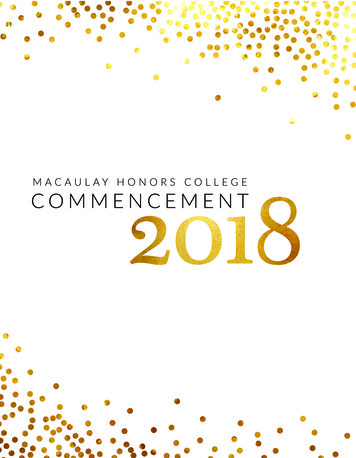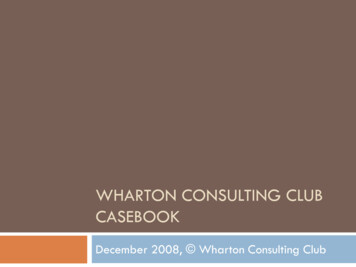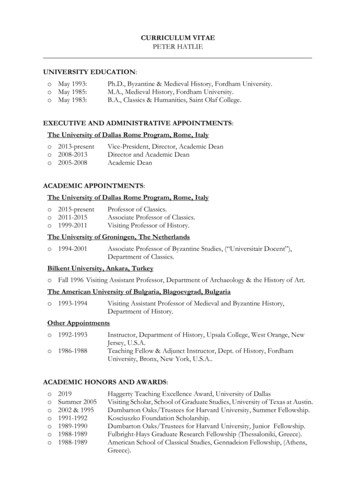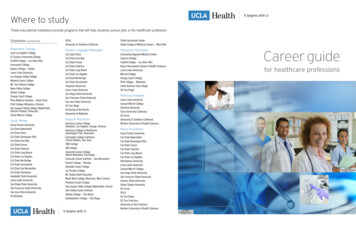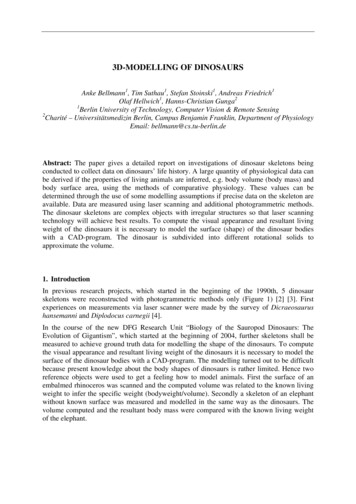
Transcription
Spartan StudentOverviewWAVEFUNCTIONWavefunction, Inc.18401 Von Karman Avenue, Suite 370Irvine, CA 92612 U.S.A.www.wavefun.comWavefunction, Inc., Japan Branch Office3-5-2, Kouji-machi, Suite 608Chiyoda-ku, Tokyo, Japan 102-0083japan@wavefun.com www.wavefun.com/japanSpartan Student is a collaboration with Q-Chem, Inc.TMA Quantum Leap Into the Future of Chemistr yQ-CHEM, INC.The Design Center, Suite 6905001 Baum Blvd., Pittsburgh, PA 15213
Copyright 2011 by Wavefunction, Inc.All rights reserved in all countries. No part of thisbook may be reproduced in any form or by anyelectronic or mechanical means including informationstorage and retrieval systems without permission inwriting from the publisher, except by a reviewer whomay quote brief passages in a review.
Table of ContentsChapter 1Spartan Student.1Chapter 2Operating Spartan Student.Opening and Exiting Spartan Student.Menus.Icons.Mouse and Keyboard Operations.Selecting Molecules, etc.Dialogs.Database.Stereo Displays.Changing Colors and Setting Preferences.Monitoring and Terminating Jobs.55567101111131313Chapter 3The File Menu.New.Open.Close.Save.Save As.Save Image As.New Molecule.Delete Molecule.Append Molecule(s).Access Database by Name.Access CACTUS.Access PDB.Print/Print Output/Print Spreadsheet.Start/Stop QuickTime pter 4The Edit Menu.Undo.Cut.Copy.20202020Table of Contentsiii
Paste.Select All.Find.Find Next.Center.Clear.202121212121Chapter 5The Model Menu.Wire.Ball and Wire.Tube.Ball and Spoke.Space Filling.Hide.Global n Plot.Hydrogen Bonds.Configure.Configure Labels.Configure Objects.Configure r 6The Geometry Menu.Measure Distance.Measure Angle.Measure Dihedral.Freeze Center.Constrain Distance.Constrain Angle.Constrain Dihedral.Define Point.Define Plane.Align.3131313132333333353536ivTable of Contents
Chapter 7The Build Menu.Model Kits.Organic Model Kit.Groups.Rings.More.Clipboard.Inorganic Model Kit.Ligands.Peptide Model Kit.Specification of Amino Acid Sequence.Specification of Macroscopic Structure.Termination.Nucleotide Model Kit.Specification of Base Sequence.Specification of Helical Structure.Accessing ChemDraw.General Molecule Building Functionality.Multiple Fragments.Bond Rotation/Bond Stretching.Atom/Fragment Replacement.Chirality Inversion.Building/Editing Menu Functions.View.Add Fragment.Delete.Make Bond.Break Bond.Minimize.Guess Transition 151515152525252535354545557Chapter 8The Setup Menu.Calculations.Calculate.Total Charge.Unpaired Electrons.5959606464Table of Contentsv
Chapter 9Print.Global Calculations.Surfaces.Common Surfaces and Property Maps.More it.64656567686869697070The Display Menu.Output.Properties.Molecule Properties and Thermodynamics.Molecule Properties.Thermodynamics.Atom Properties.Bond Properties.Constraint Properties.Point and Plane Properties.Surface Properties.Surfaces.Spectra.IR.Proton NMR.13C NMR.Spreadsheet.From the Add Dialog.Numerical Data.User-Defined Expressions.From Post ( ) 677787879808083848687909193949799Chapter 10 The Options Menu. 101Preferences. 101viTable of Contents
Settings. 102Molecule. 104VDW Radii. 106Paths. 107X-Platform. 108Toolbars. 109URLs. 110Colors. 110Fonts/Graphics Fonts. 111Monitor. 112Calculator. 113Model Kit. 113File Toolbar, Geometry Toolbar, Build Toolbar,Display Toolbar. 113Cascade, Tile. 113Chapter 11The Activities Menu. 114Chapter 11The Help Menu. 116Help. 116About. 117Appendix A Capabilities and Limitations. 118Molecular Mechanics Models. 118Semi-Empirical Models. 118Hartree-Fock Models. 118Density Functional Models. 118MP2 Møller-Plesset Models. 119Solvent Models. 119Properties and Spectra. 119Graphical Models. 119Database. 120Appendix B Menus. 121Spartan Student Screen. 121Contextual. 125Appendix C Units. 127Appendix D Citation. 129Table of Contentsvii
Chapter 1Spartan StudentThis chapter describes the architecture of Spartan Student, focusingon the connectivity of computational, graphical and databasecomponents to the user interface. Available molecular mechanicsand quantum chemical methods are enumerated and their utility andapplicability assessed.Spartan Student comprises a series of independent modules tightlyconnected via a graphical user interface that is highly functional, yetelementary and uncluttered. It has been designed not only to greatlyreduce the drudgery and possibility for human error associated with thepreparation of input, but also to guide the interpretation of output. Theinterface is perhaps best viewed as an interactive and intuitive windowinto modern molecular mechanics and quantum chemical ectraWebDatabasesPropertiesIncluded in the interface are builders for organic, inorganic andorganometallic molecules, polypeptides and polynucleotides, anda procedure for guessing transition states. Access to ChemDraw1 isprovided without having to exit the interface. Also accessible is asmall ( 5,000 molecule) subset of the Spartan Spectra and PropertiesDatabase (SSPD)2 and (if desired) an equally small subset of the SpartanChapter 11
Molecular Database (SMD)3. SSPD contains structures, infrared andNMR spectra as well as a wide variety of molecular properties obtainedfrom the EDF2/6-31G* density functional model. The wavefunctionis included, allowing quick access to a variety of graphical surfacesand property maps. SMD contains calculated structures and associatedproperties of molecules, each obtained from one or more of thetheoretical models supported in Spartan Student. On-line access tothe Protein Data Bank (PDB)4, a collection of 75,000 biologicalmacromolecular structures, is provided. Experimental infraredspectra are available from the NIST website5 and experimental NMRspectra from NMRShiftDB website.6 Finally, compounds containedin the National Cancer Institute collection of molecules (CACTUS)7may be accessed via name search. Unlike SSPD, SMD and PDB,CACTUS contains no actual structure data, only connectivityinformation (allowing construction of an approximate structure).Spartan Student’s interface provides the gateway to a range of moderncomputational methods, the simplest of which is the MMFF molecularmechanics model. It is available to determine equilibrium geometriesof molecules comprising upwards of several thousand atoms, and isthe only computational technique that is applicable to biopolymers. Itmay also be employed to establish the best (lowest-energy) conformerof organic molecules.Quantum chemical models are required to account for the geometriesof transition states as well as for reaction and activation energies.8The simplest of these are semi-empirical molecular orbital models.The PM3 model, supported in Spartan Student, has proven successfulfor determining equilibrium geometries including the geometries oftransition-metal compounds, but it is not reliable for the calculationof the reaction or activation energies.Hartree-Fock molecular orbital models are a mainstay of quantumchemical techniques, in particular, for determining equilibrium andtransition-state geometries and reaction energies, and are supported inSpartan Student with the STO-3G, 3-21G, 6-31G* and 6-311 G**basis sets. Hartree-Fock models generally provide suitable descriptionsof many types of reactions, but are not adequate for thermochemical2Chapter 1
comparisons where bonds are broken or formed. In addition, theydo not provide a proper account of the geometries of moleculesincorporating transition metals. Supported in Spartan Student are theB3LYP and EDF2 density functional models and the MP2 MøllerPlesset model. All properly account for the energies of reactionsthat involve bond making and breaking and both density functionalmodels (but not the MP2 model) properly account for the geometriesof molecules incorporating transition metals. B3LYP, EDF2 and MP2models are supported with the 6-31G* and 6-311 G** basis sets.Spartan Student provides access to infrared spectra (MMFF, PM3,Hartree-Fock, B3LYP, EDF2 and MP2 models) and NMR spectra9(B3LYP/6-31G* and EDF2/6-31G* models only). These are availableboth as numerical data (vibrational frequencies, chemical shifts) aswell as spectral plots. Experimental spectra may be read into SpartanStudent. In addition, internet access to experimental IR and NMRdatabases5,6 is available allowing direct comparison with calculatedspectra. Spartan Student allows a calculated infrared spectrum to befit on-the-fly to an experimental spectrum, using both a multiplicativescale of calculated frequencies and peak width at half height asparameters. Also provided is an empirical correction to 13C NMRchemical shifts.Spartan Student provides a variety of graphical tools to assist ininterpreting the results of calculations. These include molecularorbitals, electron and spin densities, local ionization potentials andelectrostatic potentials that can be displayed as surfaces, slices andproperty maps. Spartan Student provides the ability to distinguishaccessible and inaccessible regions on a density surface and onproperty maps based on this surface. Animations can be created andused to depict conformational changes or the progress of chemicalreactions. Animations can be saved as QuickTime files.10Chapter 13
ChemDraw is not included with Spartan Student, but may be obtained from CambridgeSoft(www.cambridgesoft.com). Seamless access to ChemDraw is not available in the Macintoshversion although both Windows and Macintosh versions are able to read ChemDraw files.2. The full Spartan Spectra and Properties Database contains 110,000 entries from the EDF2/6-31G* density functional model and is available to license. Contact info@wavefun.comfor more information.3. The full Spartan Molecular Database contains 150,000 molecules, each with up to 10theoretical models and is available to license. Contact info@wavefun.com for more information.4. PDB web reference: http://www.rcsb.org.5. NIST web reference: http://webbook.nist.gov6. NMRShiftDB web reference: http://nmrshiftdb.ice.mpg.de7. CACTUS web reference: http://cactus.nci.nih.gov8. Full discussion and assessment of the specific molecular mechanics and quantum chemicalmodels available in Spartan Student is provided in: W.J. Hehre, A Guide to MolecularMechanics and Quantum Chemical Calculations, Wavefunction, Irvine, 2003. Thisis available as a PDF on Wavefunction’s website (www.wavefun.com). See also: W.J.Hehre, L. Radom, P.v.R. Schleyer and J.A. Pople, Ab Initio Molecular Orbital Theory,Wiley, New York, 1986; Y. Shao, L.F. Molnar, Y. Jung, J. Kussmann, C. Ochsenfeld, S.T.Brown, A.T.B. Gilbert, L.V. Slipchenko, S.V. Levchenko, D.P. O’Neill, R.A. DiStasioJr., R.C. Lochan, T. Wang, G.J.O. Beran, N.A. Besley, J.M. Herbert, C.Y. Lin, T. VanVoorhis, S.H. Chien, A. Sodt, R.P. Steele, V.A. Rassolov, P.E. Maslen, P.P. Korambath,R.D. Adamson, B. Austin, J. Baker, E.F.C. Byrd, H. Dachsel, R.J. Doerksen, A. Dreuw,B.D., Dunietz, A.D. Dutoi, T.R. Furlani, S.R. Gwaltney, A. Heyden, S. Hirata, C-P. Hsu,G. Kedziora, R.Z. Khalliulin, P. Klunzinger, A.M. Lee, M.S. Lee, W.Z. Liang, I. Lotan,N. Nair, B. Peters, E.I. Proynov, P.A. Pieniazek, Y.M. Rhee, J. Ritchie, E. Rosta, C.D.Sherrill, A.C. Simmonett, J.E. Subotnik, H.L. Woodcock III, W. Zhang, A.T. Bell, A.K.Chakraborty, D.M. Chipman, F.J. Keil, A.Warshel, W.J. Hehre, H.F. Schaefer, J. Kong,A.I. Krylov, P.M.W. Gill and M. Head-Gordon, Phys. Chem. Chem. Phys., 8, 3172 (2006).9. Chemical shifts only. HH coupling constants may be evaluated empirically.10. QuickTime is a multimedia framework developed by Apple, Inc.1.4Chapter 1
Chapter 2Operating Spartan StudentThis chapter describes the general operating features of SpartanStudent.Opening and Exiting Spartan StudentTo open on Windows, click on the Start button, then click on AllPrograms, and finally click on Spartan Student (or double click on theSpartan Student icon on your desktop). To open on Macintosh, doubleclick on the Spartan Student icon in the Applications Folder. To exit,select Exit from the File menu (select Quit Spartan Student fromthe Spartan Student menu on Mac), or click the Close button ()at the top right ( top left on Mac) of the Spartan Student interface.MenusProgram functions may be accessed using pull-down menus underthe headings in the menu bar, for example, the Setup menu.FileAllows you to create a new molecule or read in a moleculethat you have previously saved, to read in an experimentalIR or NMR spectrum, to retrieve the structure, properties andIR and NMR spectra from a molecule in Spartan Student’sdatabase from its name, to retrieve a molecular structurefrom the National Cancer Institute (CACTUS) Database,to retreive a protein structure from the Protein Data Bank,to print, and to make QuickTime movies.EditAllows you to transfer information to and from the clipboard,to undo the last operation, to find text strings, to centermolecules on screen, and to delete the active molecule.Chapter 25
ModelAllows you to control the style of your model, to displaylabels on atoms, to display hydrogen bonds, to couple ordecouple molecules in a multi-molecule file, and to display aRamachandran plot for a protein structure input from PDB.Geometry Allows you to measure and constrain bond lengths, anglesand dihedrals, define points and planes, designate atoms tobe frozen, align molecules, and define points and planes.BuildAllows you to build and edit organic, inorganic andorganometallic molecules, polypeptides and polynucleotides,provides access to ChemDraw (Windows only), and toestimate a transition-state geometry based on a library ofreactions.SetupAllows you to specify the task to be performed and thetheoretical model to be employed, to request IR and NMRspectra, to specify graphical surfaces and property mapsand to submit jobs for calculation.DisplayAllows you to display text output, molecular and atomicproperties, surfaces and property maps and IR and NMRspectra, as well as to access experimental IR, and NMRspectra over the internet. Allows you to present data in aspreadsheet and make plots from these data, and to computereaction energies based either on your data or from entriesin the database associated with Spartan Student.OptionsAllows you to set display standards, specify the location ofthe database and monitor executing jobs.HelpProvides access to on-line information about SpartanStudent.A complete listing of menu functions is provided in Appendix B.IconsIcons access selected functions under the File, Build, and Geometryand Display menus, as well as other specialized functions.FileNewSave6OpenSave AsCloseAccess Database By NameChapter 2
BuildViewAdd FragmentDeleteGeometryMeasure DistanceMeasure AngleMeasure DihedralFreeze CenterMake BondBreak BondMinimizeGuess Transition StateConstrain DistanceConstrain AngleConstrain DihedralDisplayOrbital EnergiesAdditional IconsPost to Spreadsheet/ Lock/Unlock ConstraintsPlayPauseSpectraDefine PointDefine PlaneAlignPlotsGuess Transition State/ Move Up/Down Dialog/ StepMouse and Keyboard OperationsThe following functions are associated with the mouse.buttonkeyboardleftright–selection, X/Y rotate, atom/fragment exchangea,fragment insertionarange selection, Z rotateglobal X/Y rotatecX/Y translateShiftCtrlCtrl Shiftscalingbglobal X/Ytranslatescalingbmultiple selection,global Z rotatecCtrlfragment X/Y rotatefragment X/Y translatea,e(add fragment mode) chirality invertCtrl Shiftfragment Z rotatescalingb(add fragment mode) absolute configuration inverta,eChapter 27
Ctrl Shiftd (Mac)Alt (Windows)bond rotationbond rotationdbond stretchingbond stretchinga) Requires double clicking.b) Scaling is always applied to all open molecules and all fragments. The center mousewheel may also be used to scale molecules.c) Global rotations can be either molecule or screen centered. This is controlled by GlobalRotate in the Miscellaneous Preferences dialog (Preferences. under Options menu;Chapter 10).d) In Add Fragment mode with bond selected (red arrow visible).e) For Macintosh, Apple ( ) key replaces Ctrl key for chirality inversion.Mouse/keyboard operations may be broadly separated into twocategories: selection (picking) and manipulation (translation/rotation).Selection. The left button is used for selection of objects on screenand/or of menu items. Left and right buttons together are used to definea selection box for copying/cutting to the clipboard, as well as formultiple model selection. Together with the Shift key, the left buttonallows for selection over a range. Together with the Ctrl (Control)key, the left button allows for multiple selection. Both range andmultiple selection apply not only to text items in lists, but to atomsand bonds in molecules as well. In add fragment mode ( ), doubleclicking the left button on an atom leads to atom or fragment exchange.Double clicking on an atom with the Ctrl key depressed leads toinversion in chirality of the atom and double clicking anywhere on amolecule with both Ctrl and Shift keys depressed inverts the absoluteconfiguration of the molecule. Given a structure on screen, doubleclicking on the background with a fragment, group, ring or ligandselected inserts it alongside (not bonded to) the current structure.Manipulation. The left button is used for rotation and the rightbutton is used for translation and scaling of objects on screen. Withno keys depressed, the left mouse button gives rise to rotation aboutthe X and y (screen) axes, while the right mouse button gives riseto translation in the x and y (screen) directions. Together with theShift key, the left mouse button gives rise to rotation about the zdirection and the right mouse button gives rise to scaling. The center(scroll) wheel on the mouse may also be used for scaling.8Chapter 2
The Ctrl key in conjunction with the left or right mouse buttons and(optionally) the Shift key, signifies a change in focus away fromthe default for the purpose of rotations and translations. Outside ofadd fragment mode, the default is focus on a single molecule (theselected molecule). Use of the Ctrl key changes focus to the entireset of molecules on screen, meaning that rotations and translationsare carried out globally. In add fragment mode, the default is focus onthe full set of fragments that make up the molecule being constructed,and rotations and translations refer to this set of fragments as awhole. Use of the Ctrl key changes focus to a single fragment (theselected fragment), and rotations and translations now refer only tothis fragment.In add fragment mode, use of the Alt key (Windows) or option key(Mac) with the left mouse button allows for rotation about a selectedbond and, with the right mouse button, for changing the length ofthe selected bond.Additional keys control various Spartan Student functions.33 selects red-cyan stereo display. Pressing againreturns to non-stereo display.Page Up, Page Down Moves up (Page Up), down (Page Down), to the topHome, End(Home) and to the bottom (End) of the set of openmolecules. Also, moves up and down pages in theOutput dialog.InsertIn add fragment mode only, inserts a new fragmenton screen. This is accomplished by selecting thefragment from the model kit, holding down theInsert key and clicking on screen (option keyon Mac). Insertion may also be accomplishedby double clicking on the background followingselection of a fragment.DeleteDeletes a fragment, free valence, reaction arrow orthe contents of a selection box. This is accomplishedby holding down the Delete key and clicking onthe fragment, etc.Chapter 29
Enter(return on Mac)Required following text or data entry intospreadsheet or dialogs.Selecting Molecules, etc.Two or more molecules may be simultaneously displayed in SpartanStudent’s window. However, only one molecule may be selected.The selected molecule has access to all capabilities (moleculebuilding, job setup and submission and text and graphical displayand manipulation), while non-selected molecules may only bedisplayed as static images. The exceptions involve scaling and theuse of the Ctrl key.Selection of a molecule occurs by clicking on its structure model oron any of its associated graphical surfaces. This will also result indeselection of any previously selected molecule. The name of thedocument and the selected molecule’s label appear at the top of thescreen. Molecular properties for the selected molecule are availablein the Properties dialog (Display menu). Atom, bond and surfacedisplay properties, and information about geometrical constraintsmay be accessed by subsequent clicking on an atom, bond, etc.,associated with the selected molecule, following which it will behighlighted (colored gold). Clicking a second time on the selectedatom, bond etc., resets the display to molecular properties. Clickingon another molecule resu
A Quantum Leap Into the Future of Chemistry Q-CHEM, INC. The Design Center, Suite 690 . scale of calculated frequencies and peak width at half height as parameters. Also provided is an . orbitals, electron and spin densities, local ionization potentials and electrostatic potentials that c

